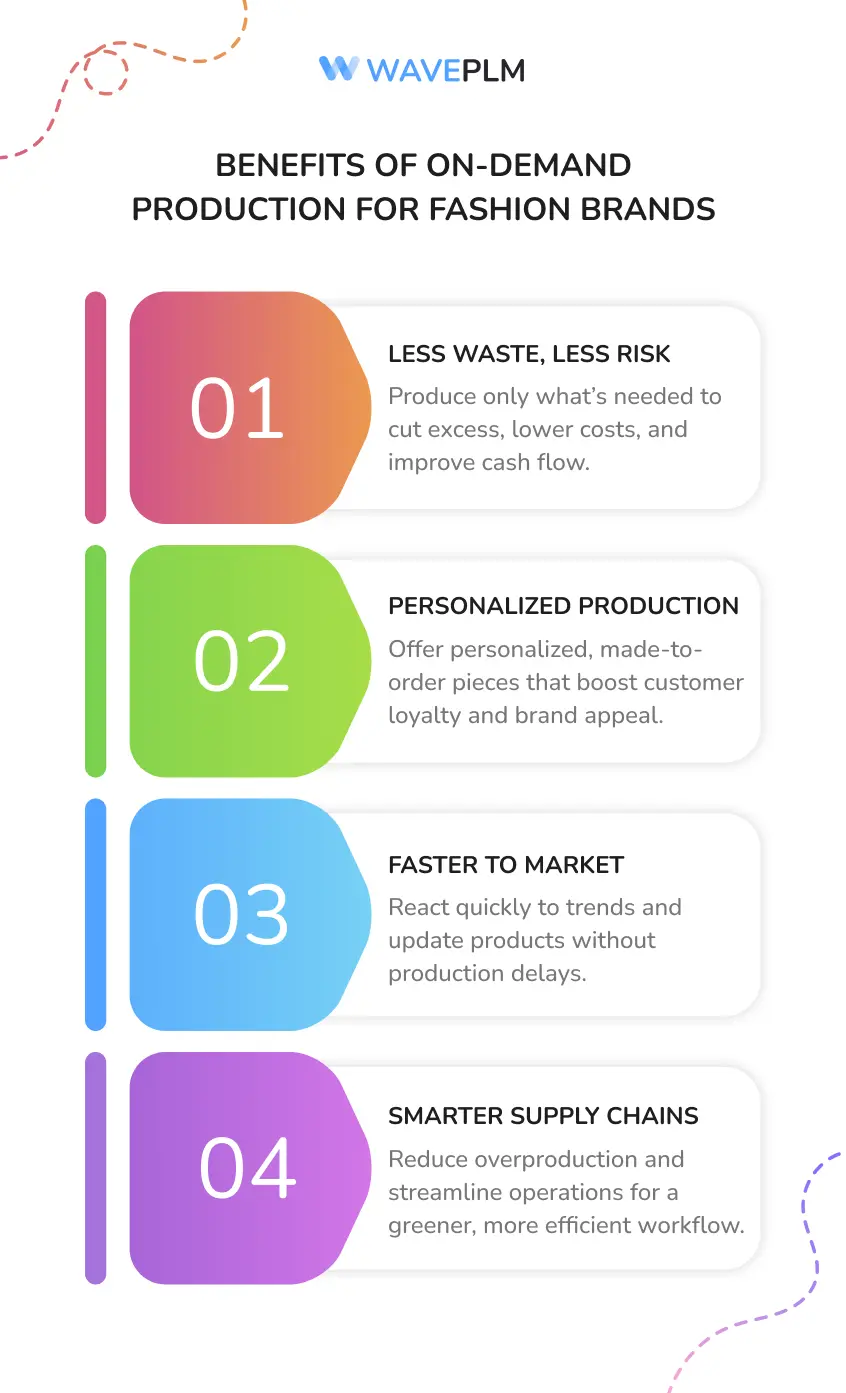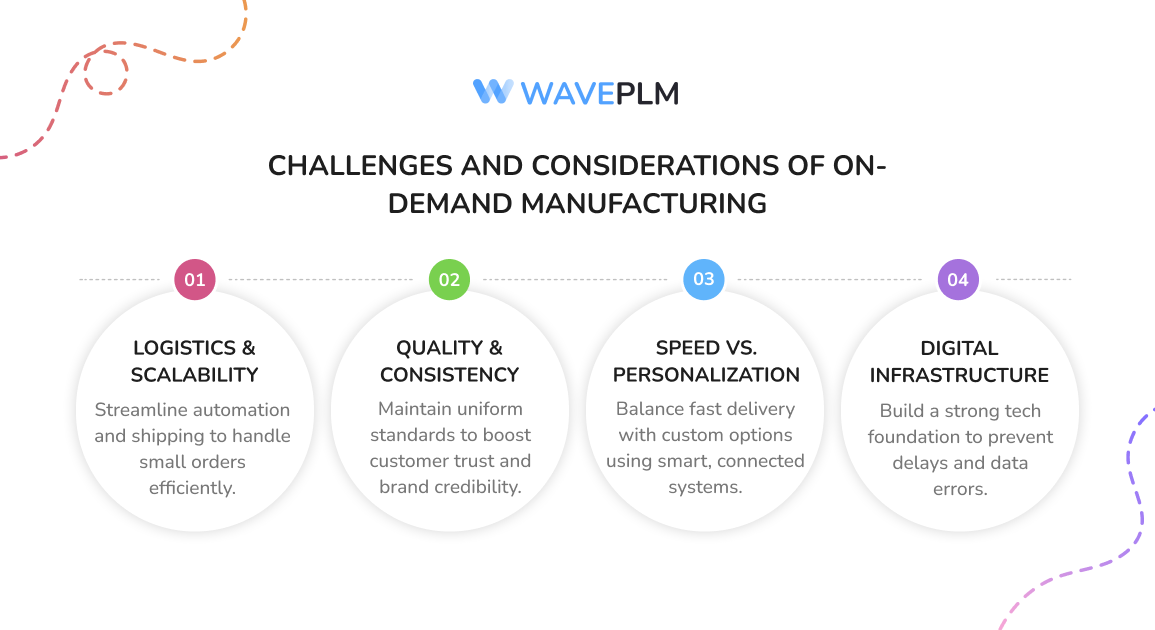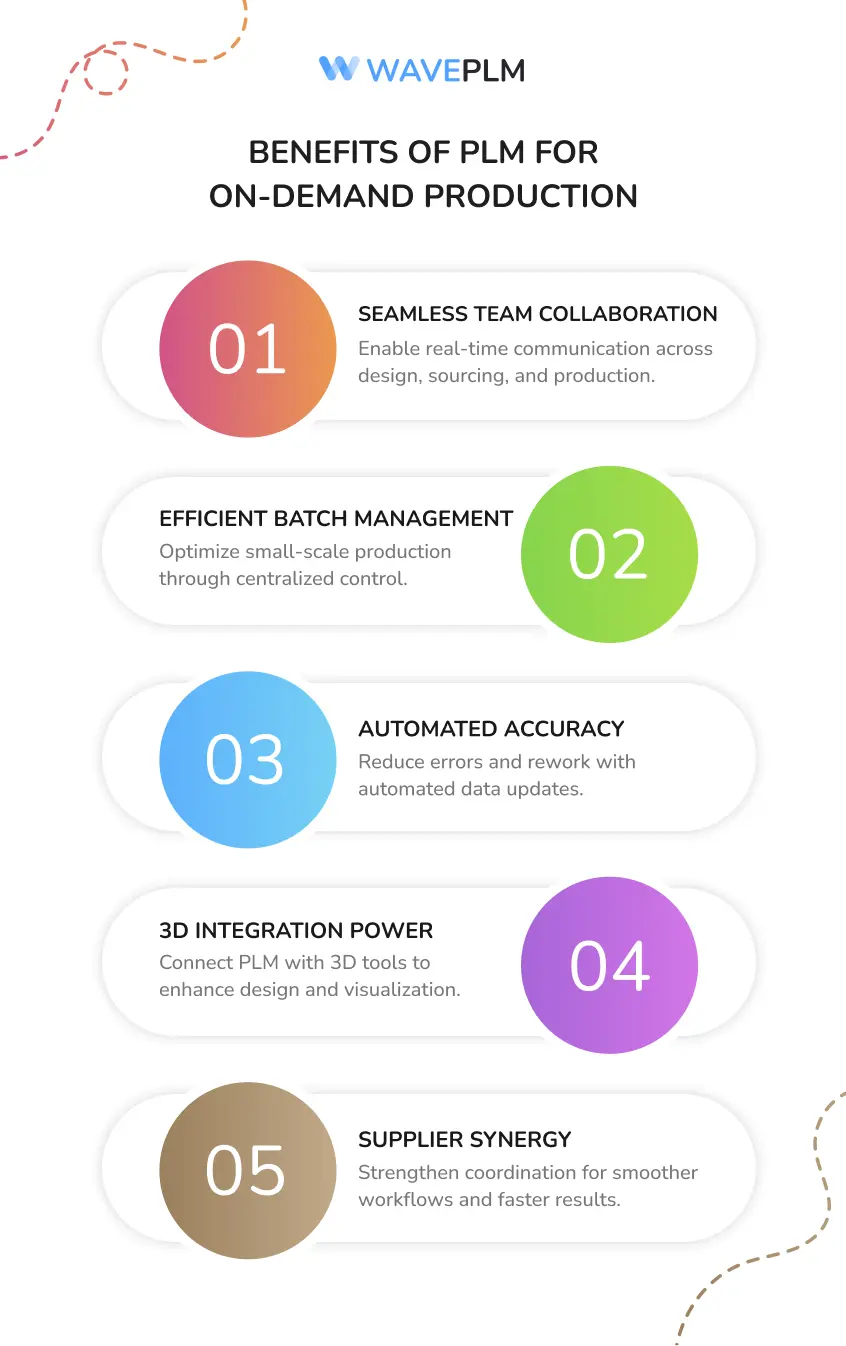
1. From Mass Production to Made On-Demand
The fashion industry relied for decades on mass production and large inventory models. This process created overproduction, high storage costs, and unsold stock that ended up as waste. The shift to made on-demand clothing marks a revolutionary change that reduces waste and boosts efficiency.
Made on-demand clothing means producing items only when customers order them. Instead of manufacturing garments in advance, on-demand models manufacture clothing in direct response to customer demand. This approach reduces waste, prevents excess inventory, and enhances customer satisfaction. The sustainable production model supports both profitability and eco-conscious values.
The digital fashion supply chain now empowers fashion brands to work smarter. PLM software fashion solutions enable real-time collaboration between designers, manufacturers, and suppliers, making the process faster and more efficient. This digital supply chain provides transparency at every stage, from raw materials to finished products.
Made on-demand clothing also enables brands to offer a wider range of products without the risk of overproduction.
2. What Is On-Demand Production in Fashion?
On-demand production fashion creates garments after customers place orders, with production initiated directly by customer orders rather than forecasts. This model contrasts with traditional production, which depends on forecasting and bulk manufacturing. It reduces inventory risk, waste, and shipping costs while allowing personalization.
Fashion brands like Printful, Unspun, and small independent designers use on-demand manufacturing to offer custom clothing production. These systems support a sustainable approach and agile apparel production.
|
Aspect |
Traditional Mass Production |
On-Demand Production |
|---|---|---|
|
Inventory |
Large stock, high storage cost |
No inventory until an order arrives |
|
Waste |
High levels of unsold stock |
Minimal waste, zero-waste production |
|
Flexibility |
Slow to adjust |
Highly flexible and quick to adapt. Brands can easily switch between different product types, such as apparel or accessories, to meet changing market demands. |
|
Speed |
Long lead times |
Faster market response and shorter delivery time |
|
Sustainability |
Resource-intensive |
Eco-friendly, efficient |
This production model enhances customer satisfaction by enabling unique designs and customization options. On-demand production enables the creation of custom products tailored to individual preferences, making it easy for customers to receive personalized merchandise.
3. Benefits of On-Demand Production for Fashion Brands
Reduced Waste and Lower Inventory Risk
On-demand manufacturing reduces waste and cuts costs by producing only what customers order. This improves cash flow and reduces inventory risk.
Personalization and Customization
Custom clothing production offers customers personalization options that strengthen brand loyalty and improve the buying experience. On-demand production also enables artists to transform their art into wearable pieces, making each item unique and meaningful.
Graphic design plays a crucial role in the creation of personalized apparel products, allowing for high-quality, custom visuals that set brands apart.
Faster Market Response
Agile apparel production lets fashion brands react to trends quickly and update product types without long delays.
Sustainable and Streamlined Supply Chains
A sustainable production model focuses on quality and reduces environmental impact while maintaining competitive pricing.
|
Metric |
Mass Production |
Made On-Demand Clothing |
|
Waste |
High |
Low |
|
Inventory |
Overstocked |
Made per order |
|
Delivery Time |
Weeks to months |
Days to weeks |
|
Personalization |
Limited |
Full customization |

4. Technology Behind Made On-Demand Clothing
The success of on-demand production relies on technology. PLM software fashion systems connect product data, design, and production teams for seamless workflow. Digital printing and 3D CAD design tools help create virtual samples and reduce physical waste. Advanced printing techniques like dye sublimation and all over print enable full-coverage designs on products. On-demand services handle all prints in-house to ensure consistent quality.
AI-driven forecasting tools enhance demand prediction accuracy. Integrated systems automate cutting, sewing, and packaging processes, ensuring the final package is prepared and shipped efficiently to the customer. Automated systems also help reduce shipping times for improved customer satisfaction.
Embroidered patches are available as a customization option, offering enhanced branding and personalization for products.
Integration with ecommerce platforms and online stores allows seamless order management, making it easy for merchants to connect their systems and manage fulfillment.
|
Step |
Tool Used |
Outcome |
|---|---|---|
|
Design |
3D Design Software |
Virtual sample ready for approval |
|
Development |
PLM Software |
Product specifications approved |
|
Production |
Automated Cutting Systems |
Optimized fabric use |
|
Delivery |
Tracking Software |
Orders ship on time |
The digital fashion supply chain ensures real-time visibility across every step of production, supporting faster, more accurate operations.
5. Challenges and Considerations
On-demand manufacturing offers great advantages but requires careful management. Customers can expect reliable delivery timelines and high product quality, especially when premium products are sourced and customization options are available.
Logistics and Scalability
Handling numerous small orders demands automation and efficient shipping options to keep delivery times low and costs under control.
Quality and Consistency
Maintaining consistent quality in small batch manufacturing ensures customer satisfaction and brand credibility.
Speed Versus Personalization
Balancing fast delivery with customization requires streamlined systems and strong digital coordination.
Digital Infrastructure
A reliable digital infrastructure and PLM-driven workflow are vital for avoiding miscommunication, production delays, and data errors.

6. Starting a Clothing Line with On-Demand Production
Launching a clothing line has traditionally required significant upfront costs, from purchasing bulk inventory to managing storage and logistics. These barriers often deter independent designers and small businesses from entering the fashion industry. However, the rise of print on demand and on demand production has transformed the landscape, making it easier than ever to start a clothing line with minimal upfront costs and virtually no inventory risk.
Print on demand websites allow you to create and sell custom clothing without the need to invest in large quantities of stock. With on demand production, each item is printed and produced only when a customer places an order. This approach means you don’t have to worry about unsold inventory or tying up cash in products that may not sell. Instead, you can focus on designing unique apparel and testing new demand products in real time.
The process is simple: upload your designs to a print on demand platform, select the apparel items you want to offer, and set your pricing. When a customer makes a purchase, the print on demand service handles the production, printing, and shipping directly to your customer. This streamlined model not only reduces costs but also allows you to quickly adapt your clothing line to market trends and customer preferences.
By leveraging print on demand products and on demand production, aspiring fashion entrepreneurs can explore new ideas, launch collections, and grow their brand without the traditional risks and expenses. Whether you’re looking to start small or scale up, this approach offers a flexible, cost-effective way to bring your clothing line to life.
6. How PLM Enables On-Demand Fashion
PLM software fashion acts as the foundation for made on-demand clothing. It connects design, sourcing, and manufacturing into one digital process.
Benefits of PLM for On-Demand Production
- Real-time collaboration for teams and suppliers
- Effective management of small batch manufacturing
- Error reduction through automated updates
- Integration with 3D design and visualization tools
- Enhanced supplier coordination and communication
|
PLM Feature |
On-Demand Production Benefit |
|
Centralized Data |
Reduces miscommunication and delays |
|
Workflow Automation |
Speeds up approvals and production |
|
Real-Time Updates |
Improves order accuracy |
|
Supplier Portal |
Strengthens collaboration |
PLM supports agile apparel production by providing visibility, reducing errors, and optimizing time-to-market.

7. The Future of On-Demand Fashion
On-demand manufacturing represents the future of the fashion industry. It is a sustainable approach that combines technology, creativity, and responsibility.
Brands that use this model operate with minimal upfront costs, reduced waste, and more control over production. The model promotes zero-waste production and small batch manufacturing for efficient resource use. Products are only manufactured after they are sold, which further reduces waste and inventory risks.
Today, made on demand offerings include a wide variety of products. T shirts and pocket tees are especially popular options, allowing for customization and unique designs. Accessories are now commonly included in made on demand product ranges, expanding opportunities for brands to offer items like bags and jewelry.
Made on demand clothing is becoming the go-to solution for brands seeking flexibility and sustainability.
PLM-driven workflows and advanced automation turn fashion into a data-driven, sustainable business. The future belongs to fashion brands that produce less but deliver better.
Key Takeaways
- Made on-demand clothing reduces waste and unsold stock.
- PLM software fashion improves visibility and collaboration.
- On-demand manufacturing allows custom clothing production.
- The sustainable production model drives the future of smart fashion.
Ready to modernize your fashion business? Explore how Wave PLM helps brands achieve efficient, on-demand production with technology, speed, and sustainability.





Leave a Reply